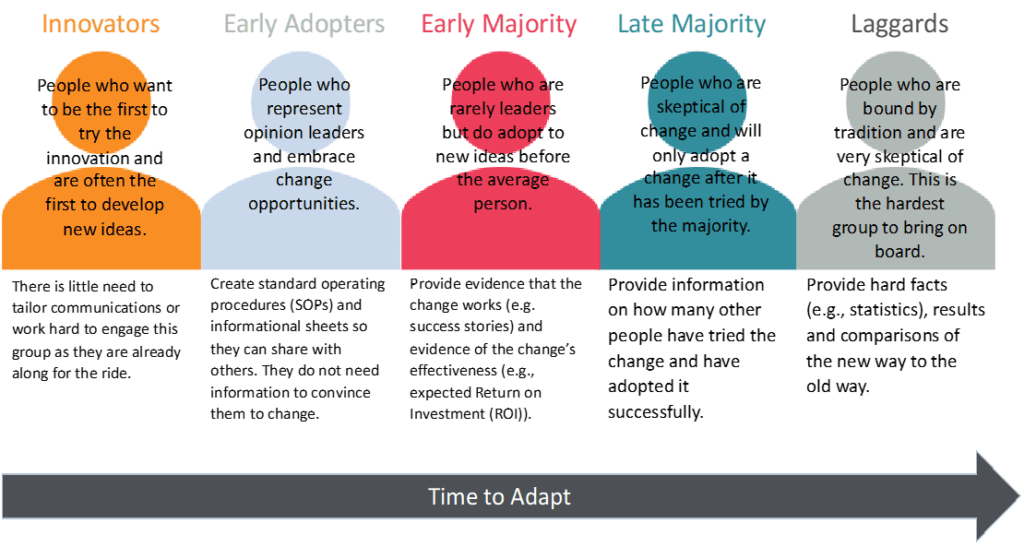Leading Others Through Change
June 11, 2020 in Keeping Up with Human Capital
By Carolyn Kurowski, Marni Falcone, Beth Chidester
In Part 1 of our change blog, we walked through how individuals react to and deal with change and provided techniques for recognizing resistance to change in yourself and others. Now that you’ve reflected on how change is internalized, we are going to dive into creating a workplace culture and environment for positive change.
Supervisors and managers can serve as models to foster a positive culture for change. In Part 1, we introduced the Bridges Transition Model that walked through the phases that individuals go through to process change; endings, the neutral zone and new beginnings. Being an empathetic leader means understanding that change can put people through crisis. It means understanding that while change is being implemented to reach a positive outcome, the road to get to that outcome is not always smooth. Think about a current or past change that your team has experienced. Where do you find the majority of your employees getting stuck? How can you figure out why they might be getting stuck? How can you assist them?
Adoption of a new idea, behavior, or product does not happen instantaneously like flipping on a light switch, but rather it is a process whereby some people are more likely to embrace than others. Diffusion of Innovation Theory[1] explains how the communication and acceptance of ideas, processes or products can best “diffuse” through an organization. A leader knows that organizations can only change if the individuals within that organization can change—so recognizing and understanding how quickly your employees are able to adapt to change and tailoring your approach is critical to successfully navigating the transition process. There are five types of adapters and your approach should change based on the makeup of your workforce.

Tailoring your approach based on the tendencies of the individuals within your organization to adapt to change is key to making an effective organizational transition. Taking into consideration all we’ve reviewed about how people adapt to change and the process by which to facilitate a smooth transition, we have provided a few tips for successfully directing a transition through change:[2]
- Provide a vision for the change. Discuss the purpose of the change, and its future impact. How does it involve employees? Will it drive performance or spark innovation? Who or what are we inspiring to change? Providing vision will engage the Innovators and turn them into champions for the change. Early Adapters and the Early Majority will need processes and facts to get on board. The Late Majority and Laggards will likey not respond to vision alone. They will need to see the direct impact and that the change is delivering on the promised results.
- Be clear and consistent regarding the change. Provide employees with information consistent with the initial vision, expected results and employee impact. Individuals who have difficulty adapting because they fear the unknown, like the Late Majority and Laggards, are particularly challenging to bring on board. Being consistent and clear maintains the engagement of the process for impact-oriented groups like the Early Adopters and Early Majority.
- Be honest. Let employees know you may not have the answers to every question, but you will do your best to find the answer. Express to employees how this change directly impacts them and their everyday work. Honesty may complicate the commitment of the Late Majoity and Laggards, but honestly will go a long way in building trust with these skeptical groups.
- Show empathy. This goes hand in hand with being honest. Acknowledge that the change may be difficult for some.Listen and see things from the employee perspective. Read more about how to lead with empathy here.
- Increase communication. Display clear and concise communication. This is particularly important for virtually distributed teams or remote employees. Tailor your communication based on the type of adapter with whom you are engaging and take advantage of the enthusiasm of the Innovators and Early Adopters to help with communication. Encourage video conferencing, schedule “check ins” and team meetings, designate a (virtual) space for employee collaboration, and provide employee feedback. Be aware of indirect or subtle cues displayed by employees that may signal anxiousness or frustration. For example:[3] [4]
- Wrinkling of the forehead
- Squinting eyes
- Lip compression
- Avoiding eye contact
- Tone of voice (e.g., meetings, e-mails)
- Avoiding responsibilities (e.g., not replying to e-mails, missing meetings, not adhering to deadlines)
As we wrap up our two part blog on change, I challenge you to reflect one final time. Think about a change you are currently facing or about to face. Perhaps, returning back to the office when quarantine eases. Ask yourself these questions:
- In what ways are your team members resistant to this change?
- How can you assist your team members through this change?
- How are you communicating this change?
- What actions can you exhibit that will create a positive environment for this change?
- Going forward, what strategies will you implement to lead your employees through change?
Change does not have to be a source of strain for employees and leaders. By reflecting, communicating, and demonstrating empathy, this can be a successful and positive experience. And remember, change is a process where we eventually learn to cope and in time, flourish.

Carolyn Kurowski, a Managing Partner with FMP, specializes in human capital planning, organizational effectiveness, and learning solutions. She loves delighting her clients with innovative solutions to their trickiest people problems. When she not trying out new ideas, you can find her at a hockey rink cheering on one of her two sons as they play what is arguably the greatest sport ever.

Marni Falcone is an Engagement Manager on FMP’s Management Team and an Industrial/Organizational Psychologist. When she isn’t leading competency development, assessment and implementation projects, she loves spending time with her family, taking a Barre3 class, or rooting for her favorite sports teams.

Beth Chidester joined FMP in October 2019 and works with the Learning and Development Center of Excellence team on training development. Beth is from Pennsylvania and when she isn’t seeking out new learning and development tools, she enjoys hiking, working out, and cheering on the Pittsburgh Steelers.
Sources:
[1] Rogers, E. Diffusion of Innovations (5th edition). Free Press.
[2] Galbraith, M. (2018). Don’t just tell employees organizational changes are coming – explain why. Harvard Business Review. Retrieved from https://hbr.org/2018/10/dont-just-tell-employees-organizational-changes-are-coming-explain-why
[3] Navarro, J. (2011) Body Language vs. micro-expressions: Debunking the myths of “micro-expressions”. Psychology Today. Retrieved from https://www.psychologytoday.com/us/blog/spycatcher/201112/body-language-vs-micro-expressions
[4] Goman, C. (2013) 6 Ways to deal with the body language of disengagement. Association for Talent Development. Retrieved from https://www.td.org/insights/6-ways-to-deal-with-the-body-language-of-disengagement